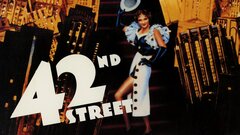Former speakeasy dancer, chorine, and Broadway lead who married musical star Al Jolson and moved with him to Hollywood, where she starred in some of the classic musicals of the 1930s. Keeler made her film debut as an aspiring showgirl in "42nd Street" (1933), opposite newcomer Dick Powell. She would be paired with the singing Powell in seven Warner Bros. extravaganzas, most of them distinguished by their elaborate, surrealistic, Busby Berkeley-designed dance routines. Keeler was sometimes the decorative centerpiece of Berkeley's bizarre numbers; buffs are unlikely to forget the jigsaw puzzle of Keeler's face in "Dames" (1934), assembled to the haunting strains of "I Only Have Eyes for You."
Although Keeler later claimed "I couldn't act. I had that terrible singing voice, and now I can see I wasn't the greatest tap dancer in the world, either," her sincere and spirited portrayals of sweet, mostly working-class, ingenues trying to get a break touched a chord in audiences during the height of the Depression. Although as a dancer she wasn't as graceful or expressive as Ginger Rogers or as speedy and technically proficient as Ann Miller or Eleanor Powell, it should be noted that Keeler essentially began as a buck-and-wing dancer.
Buck dancing was done without taps on the bottoms of one's shoes and aimed primarily at a percussive effect, with less concern for the movements of the upper body; certainly Keeler's duet with James Cagney in the "Shanghai Lil" number in "Footlight Parade" (1933) is very fun to watch and listen to.
Also notable was Keeler's duet with Lee Dixon to "Too Marvelous for Words" in one of her last musicals, "Ready, Willing and Able" (1937), performed on the keys of a giant typewriter. Keeler retired from the screen in 1941 and, after occasional TV appearances in the 50s and 60s, made one of the most heralded show business comebacks, charming Broadway in the 1971 revival of the musical "No, No, Nanette." She was married to Jolson from 1928 to 1940 and made only one musical film with him, "Go Into Your Dance" (1935).

















































































































